Teaching and Training Program
undergraduate
 |
 |
 |
 |
GEMOC's teaching program aims to:• provide undergraduate and postgraduate students with a broad, integrative understanding of Earth architecture and processes, bridging the discipline boundaries of geology and geophysics • train undergraduate and postgraduate students in new conceptual approaches and the applications of advanced technology, including geochemical analysis techniques and the integrated field and laboratory use of geographic information systems (GIS) • develop international links in teaching programs (especially postgraduate) relevant to GEMOC's goals • develop formal tailored course work components at postgraduate level which also can be packaged for distance education delivery and as short courses available to the mining industry • enhance the pool of high quality geoscience graduates by restructuring academic programs to attract a new clientele |
HIGHLIGHTS 2007
Curriculum Development

- Dr Craig O’Neill won a Young Tall Poppy Award. Craig pioneered sophisticated computer modelling tools to simulate planet formation and better understand the differences between earth and non-inhabitable planets.
- EPS successfully ran a field trip to Broken Hill with The University of Sydney. In 2008 we plan to include The University of Newcastle. All students enjoy the interaction with those that share their academic interests from other universities and find the whole experience a very stimulating learning environment.
Students on Myrtle Beach, NSW south coast on an excursion in GEOS260 Marine Depositional Environments.
- The new organic geochemistry research lab in E7B was completed in mid 2007 and is now fully operational. The new instruments for the lab have been purchased and are steadily being commissioned. Simon George has several new postgraduate students who will work in the lab.
- GEMOC was successful in recruiting 3 postgraduates funded in the first issue of the new China Government Scholarship Scheme.
- Kelsie Dadd participated in the UNESCO-funded University of the Sea program by supervising students during a 3-week Geoscience Australia research cruise on the RV Tangaroa in the Tasman Sea. The first leg of the cruise sailed from Wellington in New Zealand to Lord Howe Island. There were six final year undergraduate and postgraduate students from the Asia Pacific region who participated.
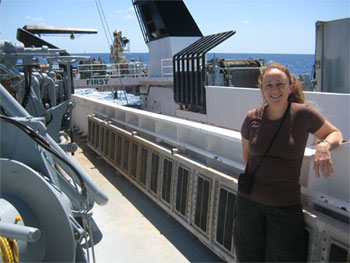
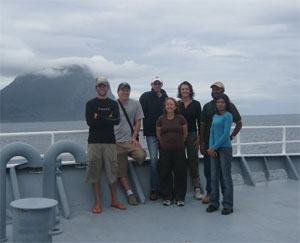
Student participants with Kelsie Dadd on the RV Tangaroa.
- The Pilbara Project was launched as a DVD called ‘LifeLab’ on the front cover of Cosmos Magazine (subscribed to by 60% of all Australian high schools) in April. The project was in collaboration with NASA, under a NASA Space Act Agreement, the University of Glamorgan in the UK and with the Macquarie ICT Innovations Centre. It won a grant of $119,500 from ASISTM (Australian Schools Innovation in Science, Technology and Maths) fund. The project has been adopted by the Victorian Space Science Education Centre in Victoria. The wiki website is at <http://pilbara.mq.edu.au> and NASA has it at <http://quest.nasa.gov/vft/> and between those two sites there is an ongoing close association with NASA plus frequent visits into Macquarie by Australian high school students. The DVD was also distributed via Cosmos to New Zealand, the USA and the UK. The site is very popular.
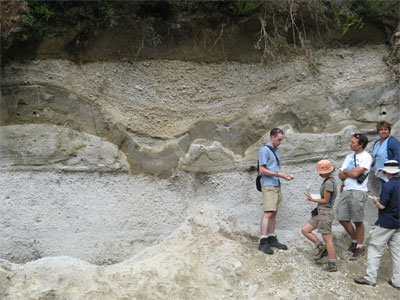 In February 2007, we ran a very successful field unit to New Zealand – GEOS373 Volcanic Geology. This is always a highlight of the year for students who enjoy the amazing volcanic landscapes while learning skills in the identification of volcanic rocks, deposits and landforms. The students visit a range of deposits from the basaltic scoria cones of the Auckland region, to the andesitic cones of Ruapehu and Ngauruhoe to rhyolitic lavas and ignimbrites around Rotorua and Taupo. The unit will run again in 2009.
In February 2007, we ran a very successful field unit to New Zealand – GEOS373 Volcanic Geology. This is always a highlight of the year for students who enjoy the amazing volcanic landscapes while learning skills in the identification of volcanic rocks, deposits and landforms. The students visit a range of deposits from the basaltic scoria cones of the Auckland region, to the andesitic cones of Ruapehu and Ngauruhoe to rhyolitic lavas and ignimbrites around Rotorua and Taupo. The unit will run again in 2009.
John Caulfield and Simon Jackson on GEOS373 Volcanic Geology.
- As in previous years, we continue to develop our “tailored problem-based learning” modules and add new problems based on real industry problems or recent research. These prepare the students for employment by ensuring they acquire a range of generic skills such as problem-solving, team work and critical thinking as well as technical content. Where possible we integrate computers into the coursework using a combination of our portable computer laboratory and more traditional computer labs. Students are introduced to a number of computer packages used in industry.
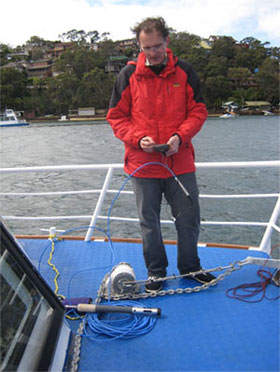
Geophysics teaching progress 2007
- Use of an extensive pool of GPS units for undergraduate (and postgraduate) fieldwork continued.
- Extended implementation of seismic, gravity, GPS and resistivity and the new GPR equipment for student field projects in exploration, groundwater, environmental and engineering geophysics.
- Equipment upgrades funded by Macquarie University over the last five years have resulted in an excellent array of new instrumentation. Acquisitions include:
Acquisitions include:
- GEOSOFT, MODELVISION, EMVISION, ERMAPPER, SeisImager, Maxwell, Profile Analyst, Discover and Reflexw software was either purchased or upgraded
- ASHTECH Z-Xtreme Differential GPS system
- DUALEM Frequency Domain EM System
- MALA Ground Penetrating Radar (GPR)
Mark Lackie on the Gunnamatta in Port Hacking, south of Sydney, during field work for GEOS116 Marine Geoscience.
GEMOC honours
The following honours projects in GEMOC were completed 2007:
Cara Danis: The Wongwibinda Complex, New England Fold Belt: A tilted Low-P High-T terrane?
The following honours projects are relevant to GEMOC in 2008:
Ben Wilkins: An investigation of the structure of the Budawang Synclinorium
Shelley Allchurch: Petrographic and geochemical characterisation of charnockitic and cumulate gabbro xenoliths from Coliban Dam, central Victoria, with implications for the evolution of the Lachlan Orogen
Peter Caffi: Evolution of an active metamorphic core complex, Suckling-Dayman Massif, eastern PNG.
Sharlin Emami: Ultramafic hornblende-olivine complex within western Fiordland orthogneiss: origin and role of cumulates in subduction systems
Melissa Murphy: Petrography and geochemistry of oceanic crust: Provenance of sedimentary detritus, Macquarie Island
Belinda Paton: Exploration Geochemistry
GEMOC postgraduate
 |
 |
 |
 |
See advertisement for GEMOC postgraduate opportunities, Appendix 6
Gemoc’s active international exchange program continued, with three recipients of the new China Government (CSC) scholarships commencing in 2008. Yoann Gréau and Véronique le Roux commenced PhD co-tutelle programs jointly with the University of Montpellier (France) and Anne Fonfrege will commence a co-tutelle with University of Jean Monnet (St Etienne, France) in 2008.
completed
Olivier Alard (PhD): Chalcophile and siderophile elements in the mantle: Geochemical characteristics and distribution; IPRS with MUIPRA stipend (graduated 2001)
Kari Anderson (PhD): Palaeozoic Eastern Gondwana: palaeomagnetic investigations of Queensland; IPRS with MUIPRA stipend (graduated 2003)
Sonja Aulbach (PhD): Evolution of the lithospheric mantle beneath the Slave Craton and Alberta Canada; IPRS with MUIPRA stipend (graduated 2004)
Elena Belousova (PhD): Zircon and apatite geochemistry: applications to petrology and mineral exploration; APA and sponsorship by Rio Tinto (graduated 2000)
Eloise Beyer (PhD): Evolution of the lithosphere beneath Tasmania and Western Norway; Field assistance from Ashton Mining (graduated 2003)
Rondi Davies (PhD): East Australian Diamonds: Characterisation and origin; Sponsored by Rio Tinto, Kennecott Canada (graduated 1999)
Guillaume Delpech (PhD): Trace-element and isotopic fingerprints in ultramafic xenoliths from the Kerguelen Archipelago (South Indian Ocean); Co-tutelle with University of Jean Monnet, IPRS with GEMOC stipend and EURODOC scholarship (graduated 2005)
Oliver Gaul (PhD): Composition of the lithospheric mantle beneath Australia; APAI collaborative with Stockdale Prospecting, CSIRO EM (graduated 2000)
Bin Guo (PhD): An integrated geophysical investigation of the Tamworth belt and its bounding faults; IPRS with MUIPRA stipend (graduated 2005)
Joanne McCarron (MSc): Mantle xenoliths from Queensland and South Australia (graduated 1997)
Bertrand Moine (PhD): The role of fluids in the genesis, segregation and crystallisation of intraplate oceanic mantle magmas: implications for crustal accretion; Co-tutelle with University of Jean Monnet (graduated 2000)
Valeria Murgulov (PhD): Lithosphere evolution and metallogeny in the Georgetown Inlier and adjacent Tasman Fold Belt, North Queensland, Australia; APA (graduated 2007)
Valeria Murgulov with supervisors Bill Griffin and Sue O’Reilly after the graduation ceremony held in April 2007.
Mark Pirlo (PhD): Australian groundwater geochemistry; applications to heat flow and exploration; APA and Queen’s Trust for Young Australians Award (graduated 2003)
Will Powell (PhD): Geochemically diverse domains in lithospheric mantle, eastern Australia; APA (graduated 2006)
Sonal Rege (PhD): Trace-element geochemistry of diamond; IPRS with iMURS scholarship (graduated 2006)
Stéphanie Touron (PhD): Geochemical fingerprints of mantle metasomatism beneath the Massif Central, France; IPRS with MURAACE scholarship (graduated 2006)
Esmé van Achterbergh (PhD): Geochemical fingerprints of mantle metasomatism (graduated 2005)
Shixin Yao (PhD): Chromite as a petrogenetic indicator in ultramafic rocks; Collaborative with Rio Tinto (graduated 2000)
Xu Xisheng (PhD): The lithospheric mantle beneath eastern China; Formal exchange PhD, Nanjing and Macquarie (graduated 2000)
current
Brad Bailey (PhD): Law Dome: Ice and crust mass balance studies (commenced 2004)
Jacques Batumike (PhD): The origin of kimberlites from the Kundelungu region (D.R. Congo) and the nature of the underlying lithospheric mantle; IPRS, iMURS (commenced 2005) (see Research Highlights)
Stephanie Carroll (PhD): The mechanisms and deep-crustal controls on continental rifting; RAACE (commenced 2005)
John Caulfield (PhD): Tofua volcano- Tonga Arc: Eruption history and timescales of magma chamber processes; iMURS (commenced 2006)
June Chevet (PhD): Gabbroic rocks from the Kerguelen Islands (Indian Ocean): a petrologic, geochemical and isotopic investigation of their origin; iMURS (commenced 2005)
David Child (PhD): Characterisation of Actinide particles in the environment for nuclear safeguards using mass spectrometric techniques (commenced part time 2007)
David Clark (PhD): Contributions to integrated magnetics - applications to the Earth Sciences (commenced 2006)
Steven Cooper (PhD): Diamonds and mantle-derived minerals, NW Australia and South Australia (commenced part time 2003)
Stephen Craven (PhD): The structural and metamorphic evolution of the Wongwibinda Complex, NSW, Australia (commenced 2006)
Heather Cunningham (PhD): A U-series isotope study of magma residence times, degassing and petrogenesis of Rabaul Caldera, Papua New Guinea; iMURS (commenced 2005)
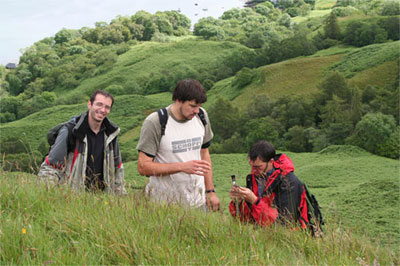 Cara Donnelly (PhD): Mantle xenoliths, kimberlites and related rocks of the Kuruman Kimberlite Province, Kaapvaal Craton, South Africa; iMURS (commenced 2007)
Cara Donnelly (PhD): Mantle xenoliths, kimberlites and related rocks of the Kuruman Kimberlite Province, Kaapvaal Craton, South Africa; iMURS (commenced 2007)
Yoann Gréau (PhD): Elemental and isotopic fractionation of siderophile and chalcophile elements: A new perspective on eclogite origin; iMURS and Co-tutelle with Montpellier University, France (commenced 2007)
GEMOC PhD student Yoann Gréau and fellow participants enjoying the International Eclogite Field Symposium excursion to the scenic Glenelg-Attadale Inlier, Scotland, July 2007.
Alan Kobussen (PhD): Composition, structure, and evolution of the lithospheric mantle beneath Southern Africa; iMURS (commenced 2006)
Véronique Le Roux (PhD): Refertilisation and isotopic variations (Sr, Nd, Hf) in the Lherz Massif (France); Eurodoc and Co-tutelle with Montpellier University, France (commenced 2007)
Weiqiang Li (PhD): Stable metal isotope geochemistry of the Cadia and Northparkes porphyry Cu-Au deposits; iMURS (commenced 2006)
Marek Locmelis (PhD): Understanding nickel deposits using platinum group element geochemistry (commenced 2006) (see Research Highlights)
Kathleen McMahon (PhD): Fracturing and deformation along the Amery Ice Shelf: A seismic study (commenced 2004)
Luke Milan (PhD): The emplacement, pressure-temperature-time path and structural evolution of lower crustal gneisses in Fiordland, New Zealand (commenced 2004)
Nenad Nikolic (PhD): Evolution of crust-mantle systems near a young rift: NW Spitsbergen, Norway; iMURS (commenced 2004) (see Research Highlights)
Ryan Portner (PhD): Spreading ridge sedimentation processes: a novel approach using Macquarie Island as a natural laboratory; iMURS (commenced 2006)
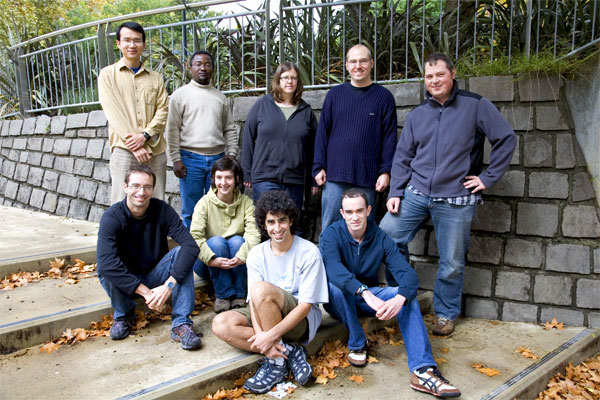
Some of GEMOC’s 2007 postgraduate students. Above: Weiqiang Li, Jacques Batumike, Cara Donnelly,Marek Locmelis and Alan Kobussen. Below: Yoann Gréau, June Chevet, Ryan Portner and John Caulfield.
commencing 2008
James Cowlyn (PhD): Growth of evolved continental crust in the primitive Tonga Arc: A study of the island of Fonualei; MQRES (EAPE CoRE)
Cara Danis (PhD): Geothermal structure of Eastern Australian Basins; APA
Anne Fonfrege (PhD): Geochemical and isotopic characterisation of magma mixing: comparative studies in volcanic and plutonic settings; Co-tutelle with Jean-Monnet University, France
Jinxiang Huang (PhD): Origin of eclogite and pyroxenite xenoliths in kimberlites and basalts; China Government Scholarship and co-tutelle with China University of Geosciences, Beijing
Lijuan Wang (PhD): Crustal evolution of the Yangtze Block using zircons in sediments; China Government Scholarship
Yamei Wang (PhD): Evolution of the subcontinental lithospheric mantle beneath the Western Block of the North China Craton: a mantle xenolith approach; China Government Scholarship

 GEMOC ARC National Key Centre
GEMOC ARC National Key Centre